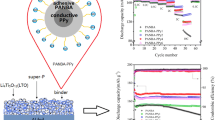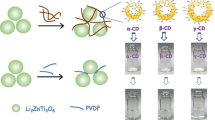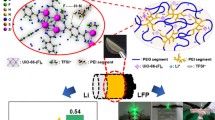Abstract
Electrode binders have significant influences on lithium-ion battery performance. Good binders should be able to absorb electrolyte to accelerate lithium-ion transport while simultaneously maintaining adequate adhesion and mechanical strength after swelling. Currently, most polymer binders are based on homo or random copolymers so they may only meet one of these requirements, as an improvement in electrolyte swelling ability is detrimental to mechanical strength, and vice versa. This work investigates whether the design of chain sequence can resolve this contradiction. Reversible addition-fragmentation chain transfer (RAFT) emulsion polymerization is employed to synthesize copolymer latex with different chain sequences as electrode binders, which are examined in both LiFePO4 cathode and silicon anodes. The results show a triblock copolymer chain sequence gives the best performance. The microphase separation in triblock copolymer distributes functionalities of electrolyte affinity and strength maintenance into disparate blocks and therefore satisfies both requirements simultaneously. The advantages of triblock chain sequence are demonstrated by superior ionic conductivity, mechanical strength after electrolyte absorption, and lithium-ion diffusion coefficient and then lead to better battery performance compared with random counterpart and commercial aqueous binders.










Similar content being viewed by others
References
Chou SL, Pan Y, Wang JZ, Liu HK, Dou SX (2014) Small things make a big difference: binder effects on the performance of Li and Na batteries. Phys Chem Chem Phys 16(38):20347–20359
Mazouzi D, Karkar Z, Hernandez CR, Manero PJ, Guyomard D, Roue L, Lestriez B (2015) Critical roles of binders and formulation at multiscales of silicon-based composite electrodes. J Power Sources 280:533–549
Chen H, Ling M, Hencz L, Ling HY, Li GR, Lin Z, Liu G, Zhang SQ (2018) Exploring chemical, mechanical, and electrical functionalities of binders for advanced energy-storage devices. Chem Rev 118(18):8936–8982
Bommier C, Ji XL (2018) Electrolytes, SEI formation, and binders: a review of nonelectrode factors for sodium-ion battery anodes. Small 14(16):1703576
Kwon TW, Choi JW, Coskun A (2018) The emerging era of supramolecular polymeric binders in silicon anodes. Chem Soc Rev 47(6):2145–2164
Komaba S, Shimomura K, Yabuuchi N, Ozeki T, Yui H, Konno K (2011) Study on polymer binders for high-capacity SiO negative electrode of Li-ion batteries. J Phys Chem C 115(27):13487–13495
Li JT, Wu ZY, Lu YQ, Zhou Y, Huang QS, Huang L, Sun SG (2017) Water soluble binder, an electrochemical performance booster for electrode materials with high energy density. Adv Energy Mater 7(24):1701185
Shi Y, Zhou XY, Yu GH (2017) Material and structural design of novel binder systems for high-energy, high-power lithium-ion batteries. Acc Chem Res 50(11):2642–2652
Choi S, Kwon TW, Coskun A, Choi JW (2017) Highly elastic binders integrating polyrotaxanes for silicon microparticle anodes in lithium ion batteries. Science 357(6348):279–283
Ryu J, Park S (2017) Sliding chains keep particles together. Science 357(6348):250–251
Magasinski A, Zdyrko B, Kovalenko I, Hertzberg B, Burtovyy R, Huebner CF, Fuller TF, Luzinov I, Yushin G (2010) Toward efficient binders for Li-ion battery Si-based anodes: polyacrylic acid. ACS Appl Mater Interfaces 2(11):3004–3010
Zhang Z, Zeng T, Qu C, Lu H, Jia M, Lai Y, Li J (2012) Cycle performance improvement of LiFePO4 cathode with polyacrylic acid as binder. Electrochim Acta 80:440–444
Lee JH, Paik U, Hackley VA, Choi YM (2005) Effect of carboxymethyl cellulose on aqueous processing of natural graphite negative electrodes and their electrochemical performance for lithium batteries. J Electrochem Soc 152(9):A1763–A1769
Yen JP, Lee CM, Wu TL, Wu HC, Su CY, Wu NL, Hong JL (2012) Enhanced high-temperature cycle-life of mesophase graphite anode with styrene-butadiene rubber/carboxymethyl cellulose binder. ECS Electrochem Lett 1(6):A80–A82
He M, Yuan LX, Zhang WX, Hu XL, Huang YH (2011) Enhanced cyclability for sulfur cathode achieved by a water-soluble binder. J Phys Chem C 115(31):15703–15709
Liu WR, Yang MH, Wu HC, Chiao SM, Wu NL (2005) Enhanced cycle life of Si anode for Li-ion batteries by using modified elastomeric binder. Electrochem Solid-State Lett 8(2):A100–A103
Song J, Zhou M, Yi R, Xu T, Gordin ML, Tang D, Yu Z, Regula M, Wang D (2014) Interpenetrated gel polymer binder for high-performance silicon anodes in lithium-ion batteries. Adv Funct Mater 24(37):5904–5910
Koo B, Kim H, Cho Y, Lee KT, Choi NS, Cho J (2012) A highly cross-linked polymeric binder for high-performance silicon negative electrodes in lithium ion batteries. Angew Chem Int Ed 51(35):8762–8767
Park HK, Kong BS, Oh ES (2011) Effect of high adhesive polyvinyl alcohol binder on the anodes of lithium ion batteries. Electrochem Commun 13(10):1051–1053
Zhang R, Yang X, Zhang D, Qiu H, Fu Q, Na H, Guo Z, Du F, Chen G, Wei Y (2015) Water soluble styrene butadiene rubber and sodium carboxyl methyl cellulose binder for ZnFe2O4 anode electrodes in lithium ion batteries. J Power Sources 285:227–234
Li J, Lewis RB, Dahn JR (2007) Sodium carboxymethyl cellulose - a potential binder for Si negative electrodes for Li-ion batteries. Electrochem Solid-State Lett 10(2):A17–A20
Lim S, Kim S, Ahn KH, Lee SJ (2015) Stress development of Li-ion battery anode slurries during the drying process. Ind Eng Chem Res 54(23):6146–6155
Abetz V, Simon PFW (2005) Phase behaviour and morphologies of block copolymers[M]//Block copolymers I. Springer, Berlin, Heidelberg, 125–212
Kwon TW, Jeong YK, Lee I, Kim TS, Choi JW, Coskun A (2014) Systematic molecular-level design of binders incorporating Meldrum’s acid for silicon anodes in lithium rechargeable batteries. Adv Mater 26(47):7979–7985
Wu M, Xiao X, Vukmirovic N, Xun S, Das PK, Song X, Olalde-Velasco P, Wang D, Weber AZ, Wang LW, Battaglia VS, Yang W, Liu G (2013) Toward an ideal polymer binder design for high-capacity battery anodes. J Am Chem Soc 135(32):12048–12056
Liu G, Xun S, Vukmirovic N, Song X, Olalde-Velasco P, Zheng H, Battaglia VS, Wang L, Yang W (2011) Polymers with tailored electronic structure for high capacity lithium battery electrodes. Adv Mater 23(40):4679–4683
Zhao H, Wang Z, Lu P, Jiang M, Shi F, Song X, Zheng Z, Zhou X, Fu Y, Abdelbast G, Xiao X, Liu Z, Battaglia VS, Zaghib K, Liu G (2014) Toward practical application of functional conductive polymer binder for a high-energy lithium-ion battery design. Nano Lett 14(11):6704–6710
Chiefari J, Chong YK, Ercole F, Krstina J, Jeffery J, Le TPT, Mayadunne RTA, Meijs GF, Moad CL, Moad G, Rizzardo E, Thang SH (1998) Living free-radical polymerization by reversible addition-fragmentation chain transfer: the RAFT process. Macromolecules 31(16):5559–5562
Moad G, Rizzardo E, Thang SH (2008) Radical addition-fragmentation chemistry in polymer synthesis. Polymer 49(5):1079–1131
Moad G, Rizzardo E, Thang SH (2009) Living radical polymerization by the RAFT process - a second update. Aust J Chem 62(11):1402–1472
Huang J, Zhao S, Gao X, Luo Y, Li B (2014) RAFT ab initio emulsion polymerization of styrene using poly(acrylic acid)-b-polystyrene trithiocarbonate of various structures as mediator and surfactant. Macromol React Eng 8(10):696–705
Luo YW, Wang R, Yang L, Yu B, Li BG, Zhu SP (2006) Effect of reversible addition-fragmentation transfer (RAFT) reactions on (mini)emulsion polymerization kinetics and estimate of RAFT equilibrium constant. Macromolecules 39(4):1328–1337
Wang X, Luo Y, Li B, Zhu S (2009) Ab initio batch emulsion RAFT polymerization of styrene mediated by poly(acrylic acid-b-styrene) trithicicarbonate. Macromolecules 42(17):6414–6421
Bohnke O, Frand G, Rezrazi M, Rousselot C, Truche C (1993) Fast ion transport in new lithium electrolytes gelled with PMMA. 1. Influence of polymer concentration. Solid State Ionics 66(1):97–104
Shi J, Yang YF, Shao HX (2018) Co-polymerization and blending based PEO/PMMA/P(VDF-HFP) gel polymer electrolyte for rechargeable lithium metal batteries. J Membr Sci 547:1–10
Guo Y, Gao X, Luo Y (2015) Mechanical properties of gradient copolymers of styrene and n-butyl acrylate. J Polym Sci B Polym Phys 53:860–868
Young WS, Epps III TH (2012) Ionic conductivities of block copolymer electrolytes with various conducting pathways: sample preparation and processing considerations. Macromolecules 45(11):4689–4697
Young WS, Kuan WF, Epps III TH (2014) Block copolymer electrolytes for rechargeable lithium batteries. J Polym Sci B Polym Phys 52(1):1–16
Chan CK, Peng H, Liu G, McIlwrath K, Zhang XF, Huggins RA, Cui Y (2007) High-performance lithium battery anodes using silicon nanowires. Nat Nanotechnol 3(1):31–35
Su X, Wu Q, Li J, Xiao X, Lott A, Lu W, Sheldon BW, Wu J (2014) Silicon-based nanomaterials for lithium-ion batteries: a review. Adv Energy Mater 4(1):1300882
Porcher W, Moreau P, Lestriez B, Jouanneau S, Guyomard D (2008) Is LiFePO4 stable in water? Toward greener Li-ion batteries. Electrochem Solid-State Lett 11(1):A4–A8
Porcher W, Moreau P, Lestriez B, Jouanneau S, Le Cras F, Guyomard D (2008) Stability of LiFePO4 in water and consequence on the Li battery behaviour. Ionics 14:583–587
Petrucci RH, Herring FG, Bissonnette C, Madura JD (2017) General chemistry: principles and modern applications: Eleventh Edition[M]. Pearson Canada Inc., Toronto, Ontario
Dehmelt H (1988) A single atomic particle forever floating at rest in free space: new value for electron radius. Phys Scr 1988(T22):102
Park M, Zhang X, Chung M, Less GB, Sastry AM (2010) A review of conduction phenomena in Li-ion batteries. J Power Sources 195(24):7904–7929
Liu H, Li C, Zhang H, Fu L, Wu Y, Wu H (2006) Kinetic study on LiFePO4/C nanocomposites synthesized by solid state technique. J Power Sources 159(1):717–720
Zhu YJ, Xu YH, Liu YH, Luo C, Wang CS (2013) Comparison of electrochemical performances of olivine NaFePO4 in sodium-ion batteries and olivine LiFePO4 in lithium-ion batteries. Nanoscale 5:780–787
Ven AVD, Bhattacharya J, Belak AA (2013) Understanding Li diffusion in Li-intercalation compounds. Acc Chem Res 46(5):1216–1225
Prosini PP, Lisi M, Zane D, Pasquali M (2002) Determination of the chemical diffusion coefficient of lithium in LiFePO4. Solid State Ionics 148(1):45–51
Churikov A, Ivanishchev A, Ivanishcheva I, Sycheva V, Khasanova N, Antipov E (2010) Determination of lithium diffusion coefficient in LiFePO4 electrode by galvanostatic and potentiostatic intermittent titration techniques. Electrochim Acta 55(8):2939–2950
Verma P, Maire P, Novak P (2010) A review of the features and analyses of the solid electrolyte interphase in Li-ion batteries. Electrochim Acta 55(22):6332–6341
Michan AL, Divitini G, Pell AJ, Leskes M, Ducati C, Grey CP (2016) Solid electrolyte interphase growth and capacity loss in silicon electrodes. J Am Chem Soc 138(25):7918–7931
Funding
This work was supported by the National Natural Science Foundation of China (Grant Nos. 21574115, 21875213, 21636008).
Author information
Authors and Affiliations
Corresponding author
Ethics declarations
Conflict of interest
The authors declare that they have no conflict of interest.
Additional information
Publisher’s note
Springer Nature remains neutral with regard to jurisdictional claims in published maps and institutional affiliations.
Electronic supplementary material
ESM 1
(DOC 4209 kb)
Rights and permissions
About this article
Cite this article
Zheng, Z., Gao, X. & Luo, Y. Influence of copolymer chain sequence on electrode latex binder for lithium-ion batteries. Colloid Polym Sci 297, 1287–1299 (2019). https://doi.org/10.1007/s00396-019-04548-9
Received:
Revised:
Accepted:
Published:
Issue Date:
DOI: https://doi.org/10.1007/s00396-019-04548-9




